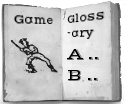Stones: Difference between revisions
Jump to navigation
Jump to search
(Glossary import) |
No edit summary |
||
| Line 3: | Line 3: | ||
|Game Family=Baseball | |Game Family=Baseball | ||
|Location=Ireland | |Location=Ireland | ||
|Description=According to Gomme (1898), | |Description=<p>According to Gomme (1898), a game played in Ireland in about 1850, using either a ball or a lob-stick. A circle of about a half-dozen stones is arranged, one for each player in the in team. A member of the out team throws the ball/stick is thrown at one of the stones. If the defending player hits it, all members of the out team must move to another stone. The teams exchange places if a stone is hit, the ball/stick is caught, or a player is hit while running between stones.</p> | ||
|Sources=<p><span>A. B. Gomme, </span><em>The Traditional Games of England, Scotland, and Ireland</em><span> (David Nutt, London, 1898), pages 216-217.</span></p> | |||
}} | }} | ||
Revision as of 10:27, 6 June 2012
| Game | Stones |
|---|---|
| Game Family | Baseball |
| Location | Ireland |
| Regions | |
| Eras | |
| Invented | |
| Tags | |
| Description | According to Gomme (1898), a game played in Ireland in about 1850, using either a ball or a lob-stick. A circle of about a half-dozen stones is arranged, one for each player in the in team. A member of the out team throws the ball/stick is thrown at one of the stones. If the defending player hits it, all members of the out team must move to another stone. The teams exchange places if a stone is hit, the ball/stick is caught, or a player is hit while running between stones. |
| Sources | A. B. Gomme, The Traditional Games of England, Scotland, and Ireland (David Nutt, London, 1898), pages 216-217. |
| Source Image | [[Image:|left|thumb]] |
| Comment | Edit with form to add a comment |
| Query | Edit with form to add a query |
| Has Supplemental Text |
Comments
<comments voting="Plus" />
